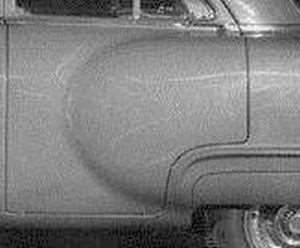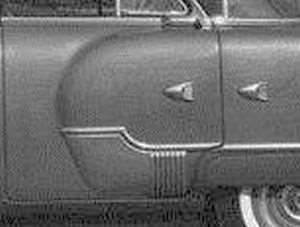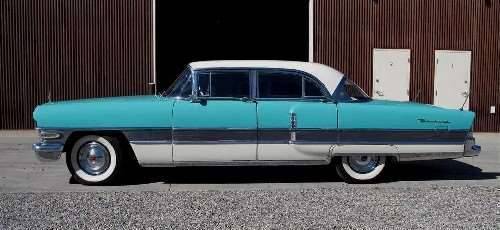|
Re: Survival revisitted
|
||||
|---|---|---|---|---|
|
Home away from home

|
Good discusson guys, never knew the story on Creative.
One more work-up showing window-up details, with pillared style because easiest to productionize. Were non-pillared possible would have been good to include. As before: 127" wheelbase, 5" extended rear overhang, 5" extended coupe roof for rear legroom, 2" roof height/beltline/seat drop, Predictor front with hidden lamps, max number of body molds sectioned/rewelded after run-out of '56 production, 440 V8 and improved Torsion-Level as planned, coupe/convertible on 122" wheelbase. Thanks and appreciation for donor photo.
Posted on: 2016/4/2 9:26
|
|||
|
||||
|
Re: Survival revisitted
|
||||
|---|---|---|---|---|
|
Home away from home

|
Hi Paul
That would have been one sweet '57 Predictor four door pillared hardtop! Before I launch into my usual diatribe, for those who find these speculative explorations tedious and/or pointless, a gentle reminder that we all find our own ways to exercise our Packard fascinations, happily do so whether anyone else shares our enthusiasms. For us, our enjoyment of Packard in all its facets, includes not only what was and is but also what might have been. For 1957, more than anything else, current trend proportions i.e. longer, lower and wider plus fresh, appealing styling were what Packard had to present to have a competitive chance. Anything taller than 58"-59" was going to be out of step. If they couldn't arrive at that with an all-new car, lowering the existing body on a carrryover chassis was their only available route. At the eleventh hour, such a concentrated, ambitious program would have been an all-in, hail-Mary pass to forestall demise. There was still a $25M short-term line of credit to call upon, which Nance could have been brought to bear. This could have been the product program to do so. Dramatically proportioned with Predictor-styled features would have caught the public's attention. Reducing models to just the core luxury offerings, putting their best cars forward, would put the public on notice that Packard wasn't to be dismissed yet. "Also concluded that, were feasible, sectioning the tools was most cost-effective approach rather than sectioning every panel stamped from them." As building method, sectioning was very labor-intensive, really only useful for the lowest-volume, highest-priced models. Though more costly up front, modifying the tooling dies would have been the way to reasonably enable volume production. Given the all-new '57 Cadillacs and Imperials plus an economy sliding into the 1958 Eisenhower Recession, it was going to be one of the most competitively challenging environments to keep Packard alive. Still your '57's might well have saved their auto-making; if not, they would have gone out with a bang.....like the Cord 810/812, rather than a whimper! (No offense intended to the South Bend Packard enthusiasts.) Steve
Posted on: 2016/4/2 16:08
|
|||
|
.....epigram time.....
Proud 1953 Clipper Deluxe owner. Thinking about my next Packard, want a Clipper Deluxe Eight, manual shift with overdrive. |
||||
|
||||
|
Re: Survival revisitted
|
||||
|---|---|---|---|---|
|
Home away from home
|
58L8184 --- Your restyling ideas for a '57 Packard Predictor remind me of what Cadillac did to the '41 Sixty Special. It looked so much different than the '39 and '40 models. All of this with some lowering tricks and new front end sheet metal. It could have happened again.
(o{]o)
Posted on: 2016/4/3 14:06
|
|||
|
We move toward
And make happen What occupies our mind... (W. Scherer) |
||||
|
||||
|
Re: Survival revisitted
|
||||
|---|---|---|---|---|
|
Forum Ambassador
|
Quote:
As building method, sectioning was very labor-intensive, really only useful for the lowest-volume, highest-priced models. Though more costly up front, modifying the tooling dies would have been the way to reasonably enable volume production. How was the 5" added to the junior bodies behind the doors to get the 127" offerings. I've read articles where it was referred to as some new process of stretching or pulling the metal. Is that considered sectioning or did they actually so something with the dies or was it truly a new non stamping process.
Posted on: 2016/4/3 15:04
|
|||
|
Howard
|
||||
|
||||
|
Re: Survival revisitted
|
||||
|---|---|---|---|---|
|
Forum Ambassador

|
They were called "plastic" dies, though they were not plastic themselves but the name referred to some type of plastic deformation of the steel panel, or at least that's the understanding I recall from the article years back in The Packard Cormorant about the process. I'll have to dig out the article and refresh my understanding.
Posted on: 2016/4/3 15:55
|
|||
|
||||
|
Re: Survival revisitted
|
||||
|---|---|---|---|---|
|
Forum Ambassador

|
Quote:
How was the 5" added to the junior bodies behind the doors to get the 127" offerings. I've read articles where it was referred to as some new process of stretching or pulling the metal. Is that considered sectioning or did they actually so something with the dies or was it truly a new non stamping process. It's the same outer roof panel from Junior to Senior - sedan-for-sedan and hardtop-for-hardtop, within a given year. Look at the P/Ns in the parts book for the rain gutters; the 56th Series Seniors differ only because of the wider/taller molding. Also, take a look at where the roof ands WRT to the rear wheel openings - Junior vs. Senior. I'm not sure how they accomplished the stretch with the floor pan, as I've not fully explored and compared that area. However, to make the Senior door, they took a Junior inner door panel, added a rear extension, below the belt, and then tool up for a new, longer outer panel (skin).
Posted on: 2016/4/4 10:08
|
|||
|
||||
|
Re: Survival revisitted
|
||||
|---|---|---|---|---|
|
Home away from home

|
Hi Howard
The 5" inch difference between the 122" versus 127" wb sedans is all added by the way the rear door opening - wheelhouse intrusions are handled. The latter has much less, seen in the relative position of the lower door edges relative to the axle center-line. See the detail views below. At the window belt-line, doors of both wheelbase models are the same, but the five inch addition allows the rear seat to be placed further rearward for greater legroom. Both bodies are identical through the B-pillar, to make the 127" wb sedan, all other panels are unique including the roof shell, only the trunk lids interchange. Packard and Briggs didn't arrive at this without inspiration: its the method Fisher employed to create the 1948-49 Cadillac 60 Special body as an extension of the standard C-body used by Olds 98, Buick Super and Roadmaster and Cadillac Series 62. A definition: Sectioning refers to removing a band of metal horizontally throughout the complete body below the window belt-line. Its the counterpart to chopping the top. Both methods were used to achieve a lower profile, the former is far more involved. Steve Attach file:  (8.87 KB) (8.87 KB)  (8.59 KB) (8.59 KB)
Posted on: 2016/4/5 7:24
|
|||
|
.....epigram time.....
Proud 1953 Clipper Deluxe owner. Thinking about my next Packard, want a Clipper Deluxe Eight, manual shift with overdrive. |
||||
|
||||
|
Re: Survival revisitted
|
||||
|---|---|---|---|---|
|
Forum Ambassador
|
Thanks. I did know about the sedans having different door profiles but I was more curious about the lengthening of the hardtops in the area behind the door. O_D touched upon the process and we may have read the same article. I was hoping to get a bit more in depth info on exactly how it was done.
I remember vaguely the article said for some reason Packard didn't want to or maybe couldn't get new dies to make a new quarter panel stamping. They turned instead to some new process where the metal was "stretched" in some fashion that didn't require the use of stamping dies. IIRC, they said the Packard use was maybe not a first but definitely was a process not in common use in the industry. It may have also been the largest panel formed in this fashion. I sure don't remember seeing any signs of adding a piece to the existing quarter panels so it must have been a one piece panel. There was a show not too long ago showing mfg of an aluminum bodied vehicle. Aluminum sheet was heated, grabbed by some huge jaws and pulled down over a form. A giant box like enclosure came down and the pulling along with high air pressure caused the panel to conform to a certain shape. I was wondering if that might have been the process except Packard managed it in harder steel rather than aluminum. The machine used for the aluminum was huge and I can't imagine something like that was available then.
Posted on: 2016/4/5 9:43
|
|||
|
Howard
|
||||
|
||||
|
Re: Survival revisitted
|
||||
|---|---|---|---|---|
|
Home away from home
|
The "plastic" forming process was only used on some inner panels to make the 127 wb hardtops. If you look up under the rear fenders of a V8 400, you will see two inner fenders at the front, 5 inches apart. Those adaptations were formed by that process. The rear quarters themselves were stamped in the normal fashion.
In all the 51-56 cars the 127 wb sedans had a 5 inch deeper C pillar area that enabled the rear seat to be set 5 inches farther back. This was a brilliant solution as it enabled the door uppers and frames and many other expensive to tool parts to be the same over the whole line. Even the rear door skins were stamped on the same die, they were just "short sheeted" and trimmed for the juniors.
Posted on: 2016/4/5 11:35
|
|||
|
||||










